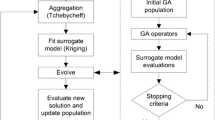Abstract
Uncertainty quantification for geomechanical and reservoir predictions is in general a computationally intensive problem, especially if a direct Monte Carlo approach with large numbers of full-physics simulations is used. A common solution to this problem, well-known for the fluid flow simulations, is the adoption of surrogate modeling approximating the physical behavior with respect to variations in uncertain parameters. The objective of this work is the quantification of such uncertainty both within geomechanical predictions and fluid-flow predictions using a specific surrogate modeling technique, which is based on a functional approach. The methodology realizes an approximation of full-physics simulated outputs that are varying in time and space when uncertainty parameters are changed, particularly important for the prediction of uncertainty in vertical displacement resulting from geomechanical modeling. The developed methodology has been applied both to a subsidence uncertainty quantification example and to a real reservoir forecast risk assessment. The surrogate quality obtained with these applications confirms that the proposed method makes it possible to perform reliable time–space varying dependent risk assessment with a low computational cost, provided the uncertainty space is low-dimensional.


















Similar content being viewed by others
References
Aguilera-Morillo MC, Durbán M, Aguilera AM (2017) Prediction of functional data with spatial dependence: a penalized approach. Stochastic Environ Res Risk Assess 31(1):7–31
Bigoni F, Della Rossa E, Francesconi A, Imagambetov K, Tumbarello G (2013) A pragmatic way to handle uncertainty analysis in a brown field, Karachaganak field Republic of Kazahstan. SPE-Europec EAGE
Burman P (1989) A comparative study of ordinary cross-validation, v-fold cross-validation and the repeated learning-testing methods. Biometrika 76(3):503–514
Caers J, Menafoglio A, Grujic O (2016) Universal kriging of functional data: trace-variography vs cross-variography? Application to gas forecasting in unconventional shales. Spat Stat 15:39–55
Capasso G, Mantica S (2006) Numerical simulation of compaction and subsidence using ABAQUS. In: Proceedings of the ABAQUS users conference, Boston USA
Coussy O (1995) Mechanics of porous continua. Wiley, New York
Da Veiga S, Gervais V (2015) Uncertainty analysis and history matching on grid responses from a reduced-basis approach. In: 77th EAGE conference and exhibition 2015
Dudley JW, van der Linden A, Mah KG et al (2009) Predicting accelerating subsidence above the highly compacting Luconia carbonate reservoirs, offshore Sarawak Malaysia. SPE Reserv Eval Eng 12(01):104–115
Floris FJ, Bush MD, Cuypers M, Roggero F, Syversveen A-R (1999) Comparison of production forecast uncertainty quantification methods: an integrated study. In: 1st Symposium on petroleum geostatistics, Toulouse, pp 20–23
Giraldo R, Delicado P, Mateu J (2008) Functional Kriging: total model. In: Eighth international geostatistics congress proceedings, vol 2, pp 1161–1166
Hastie T, Tibshirani R, Friedman J (2009) The elements of statistical learning, 2nd edn. Springer, New York
Josset L, Ginsbourger D, Lunati I (2015) Functional error modeling for uncertainty quantification in hydrogeology. Water Resour Res 51(2):1050–1068
Le Gratiet L, Cannamela C (2015) Cokriging-based sequential design strategies using fast cross-validation techniques for multi-fidelity computer codes. Technometrics 57(3):418–427
Leguijt J (2012) Using two-point geo-statistics reservoir model parameters reduction. In: ECMOR XIII-13th European conference on the mathematics of oil recovery
Menafoglio A, Dalla Rosa M, Secchi P (2013) Universal Kriging Predictor for spatially dependent functional data of a Hilbert space. Electron J Stat 7:2209–2240
Monestiez P, Nerini D (2008) Kriging predictions of curves when spatial data are curves: an extension of cokriging to functional data. In: Eighth international geostatistics congress proceeding, vol 1, pp 379–387
Myers R, Montgomery D, Anderson-Cook C (2009) Response surface methodology: process and product optimization using designed experiments. Wiley series in probability and statistics. Wiley, New York
Nerini D, Monestiez P, Manté C (2010) Cokriging for spatial functional data. J Multivar Anal 101(2):409–418
Ramsay J, Silvermann BW (2005) Functional data analysis, 2nd edn. Springer, New York
Scheidt C, Zabalza-Mezghani I, Feraille M, Collombier D (2007) Toward a reliable quantification of uncertainty on production forecasts: adaptive experimental designs. Oil Gas Sci Technol Rev IFP 62(2):207–224
Schofield A, Wroth C (1968) Critical state soil mechanics. McGraw-Hill, New York
Sulak A, Danielsen J (1988) Reservoir aspects of Ekofisk subsidence. Offshore Technology Conference, 2–5 May, Houston, Texas
Thenon A, Gervais V, Le Ravalec M (2016) Multi-fidelity meta-modeling for reservoir engineering—application to history matching. Comput Geosci 20(6):1231–1250
Wackernagel H (2003) Multivariate geostatistics: an introduction with applications, 3rd edn. Springer, New York
Xu H, Dvorkin J, Nur A (2001) Linking oil production to surface subsidence from satellite radar interferometry. Geophys Res Lett 28(7):1307–1310
Yeten B, Castellini A, Guyaguler B, Chen W (2005) A comparison study on experimental design and response surface methodologies. SPE Reserv Simul Symp 41:164–171
Zienkiewicz OC, Taylor RL (2000) The finite element method: solid mechanics, vol 2. Butterworth-Heinemann, Oxford
Acknowledgements
The authors acknowledge Eni for the permission to publish this work, the anonymous reviewers and Dario Grana for helpful comments and suggestions.
Author information
Authors and Affiliations
Corresponding author
Rights and permissions
About this article
Cite this article
Bottazzi, F., Della Rossa, E. A Functional Data Analysis Approach to Surrogate Modeling in Reservoir and Geomechanics Uncertainty Quantification. Math Geosci 49, 517–540 (2017). https://doi.org/10.1007/s11004-017-9685-y
Received:
Accepted:
Published:
Issue Date:
DOI: https://doi.org/10.1007/s11004-017-9685-y




